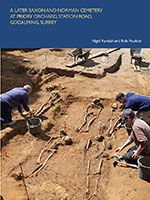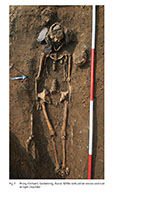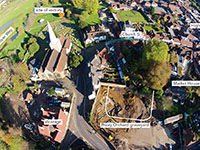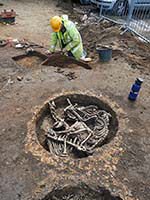 Excavations at the Priory Orchard site in Godalming revealed a nationally important later Saxon and Norman cemetery, a report on which has just been published. Over 300 inhumations and large quantities of charnel were excavated from a densely packed graveyard that must have originally contained thousands of bodies. The cemetery originally belonged to the nearby church of St Peter and Paul's, which includes Late Saxon workmanship. Its period of use, demonstrated by 103 radiocarbon dates, extended from the early 9th century to the early 12th century and, during that period, everyone who lived in the large territory of Godalming hundred was buried there.
Excavations at the Priory Orchard site in Godalming revealed a nationally important later Saxon and Norman cemetery, a report on which has just been published. Over 300 inhumations and large quantities of charnel were excavated from a densely packed graveyard that must have originally contained thousands of bodies. The cemetery originally belonged to the nearby church of St Peter and Paul's, which includes Late Saxon workmanship. Its period of use, demonstrated by 103 radiocarbon dates, extended from the early 9th century to the early 12th century and, during that period, everyone who lived in the large territory of Godalming hundred was buried there.
 Distinctive features included two burials with loomweights and one with a linen smoother, all female. More common accompaniments for the dead were stones supporting the head (pillow stones). Unique to this cemetery was the phenomenon of 'ash halos' observed around the head in eleven burials. It is suggested that these, like the pillow stones, reflect a focus on ensuring that the head was properly arranged in preparation for the Resurrection.
Distinctive features included two burials with loomweights and one with a linen smoother, all female. More common accompaniments for the dead were stones supporting the head (pillow stones). Unique to this cemetery was the phenomenon of 'ash halos' observed around the head in eleven burials. It is suggested that these, like the pillow stones, reflect a focus on ensuring that the head was properly arranged in preparation for the Resurrection.
Twelve burials include nails that were placed deliberately, though serving no identifiable practical function. Their purpose was to restrain the dead in a period when documents suggest an endemic fear that occasional sinister, malevolent or alien individuals might not lie quiet, and should be neutralized to forestall trouble.
 The cemetery forms part of remarkable body of evidence for the 9th to 12th century development of Godalming. Immediately south of it was a planned settlement whose Late Saxon origins have been demonstrated by excavation. It belonged, like the church, to the rectory manor, one of two Godalming manors recorded by Domesday Book. The larger, royal manor lay round 0.5km to the east where documents demonstrate the existence of a second planned settlement and, immediately next to it, archaeology has revealed the site of the 8th to 12th century manorial centre.
The cemetery forms part of remarkable body of evidence for the 9th to 12th century development of Godalming. Immediately south of it was a planned settlement whose Late Saxon origins have been demonstrated by excavation. It belonged, like the church, to the rectory manor, one of two Godalming manors recorded by Domesday Book. The larger, royal manor lay round 0.5km to the east where documents demonstrate the existence of a second planned settlement and, immediately next to it, archaeology has revealed the site of the 8th to 12th century manorial centre.
 The medieval town only developed in the area between the two early settlement areas after about 1250. Tanning was always an important industry in the town and the excavations revealed that, after the cemetery was abandoned, the area was used for that industry.
The medieval town only developed in the area between the two early settlement areas after about 1250. Tanning was always an important industry in the town and the excavations revealed that, after the cemetery was abandoned, the area was used for that industry.
Surrey County Archaeological Unit's publication, 'A Later Saxon and Norman Cemetery at Priory Orchard, Station Road, Godalming, Surrey' by Nigel Randall and Rob Poulton is available to purchase from the foyer at Surrey History Centre and on the Surrey Heritage online shop.
Images
Select image to view a larger version.
- Cover of the new publication with the photo showing burials neatly arranged in rows
- A typical supine burial with pillow stones around the head and a nail at the right shoulder. Note the skulls and long bones from earlier that had been disturbed
- Aerial view, looking east, of the cemetery site in relation to the church and local area
- Tanning pits with yellow clay linings and the bones of some of the animals, including horse, pig and dog, used for their skins

